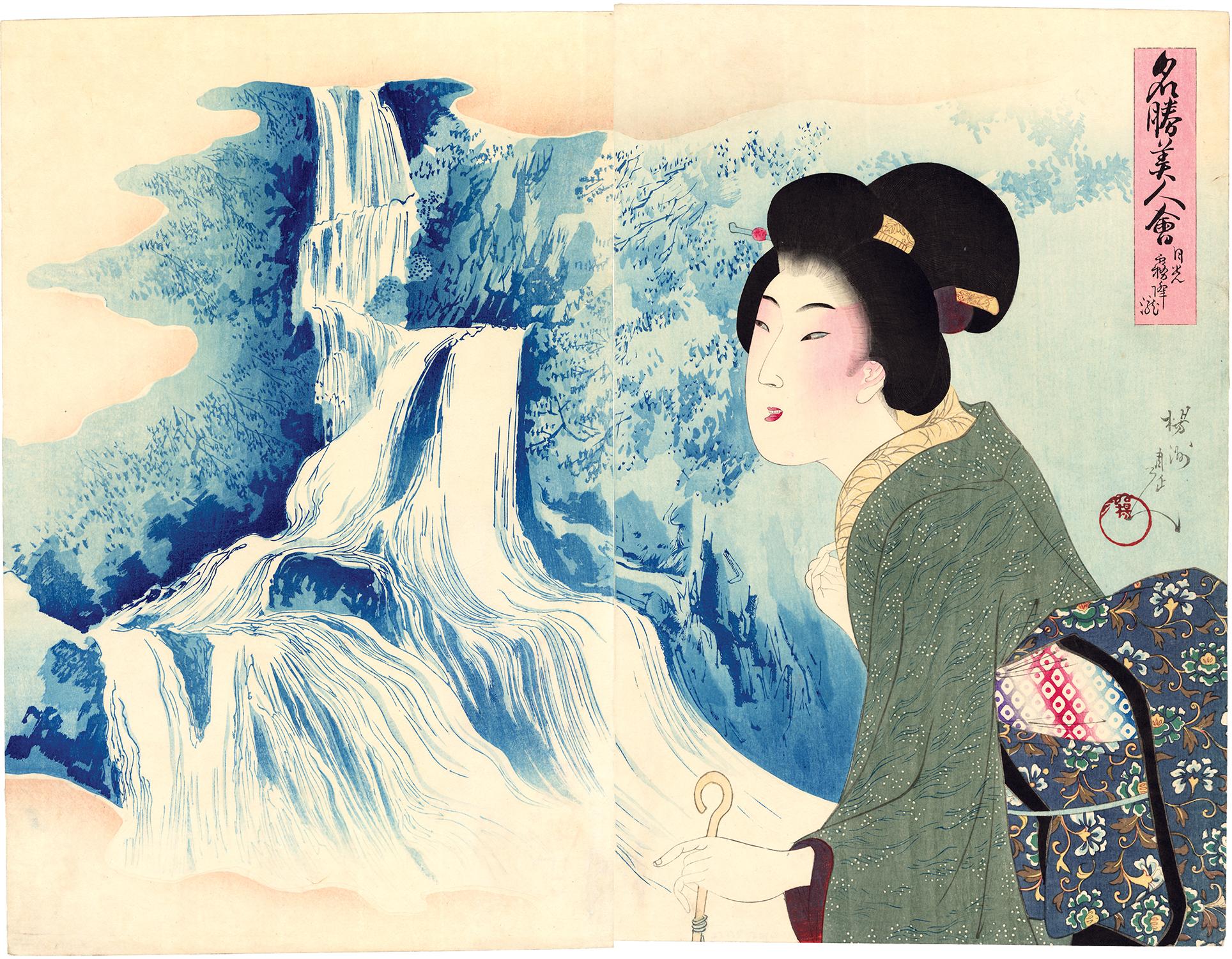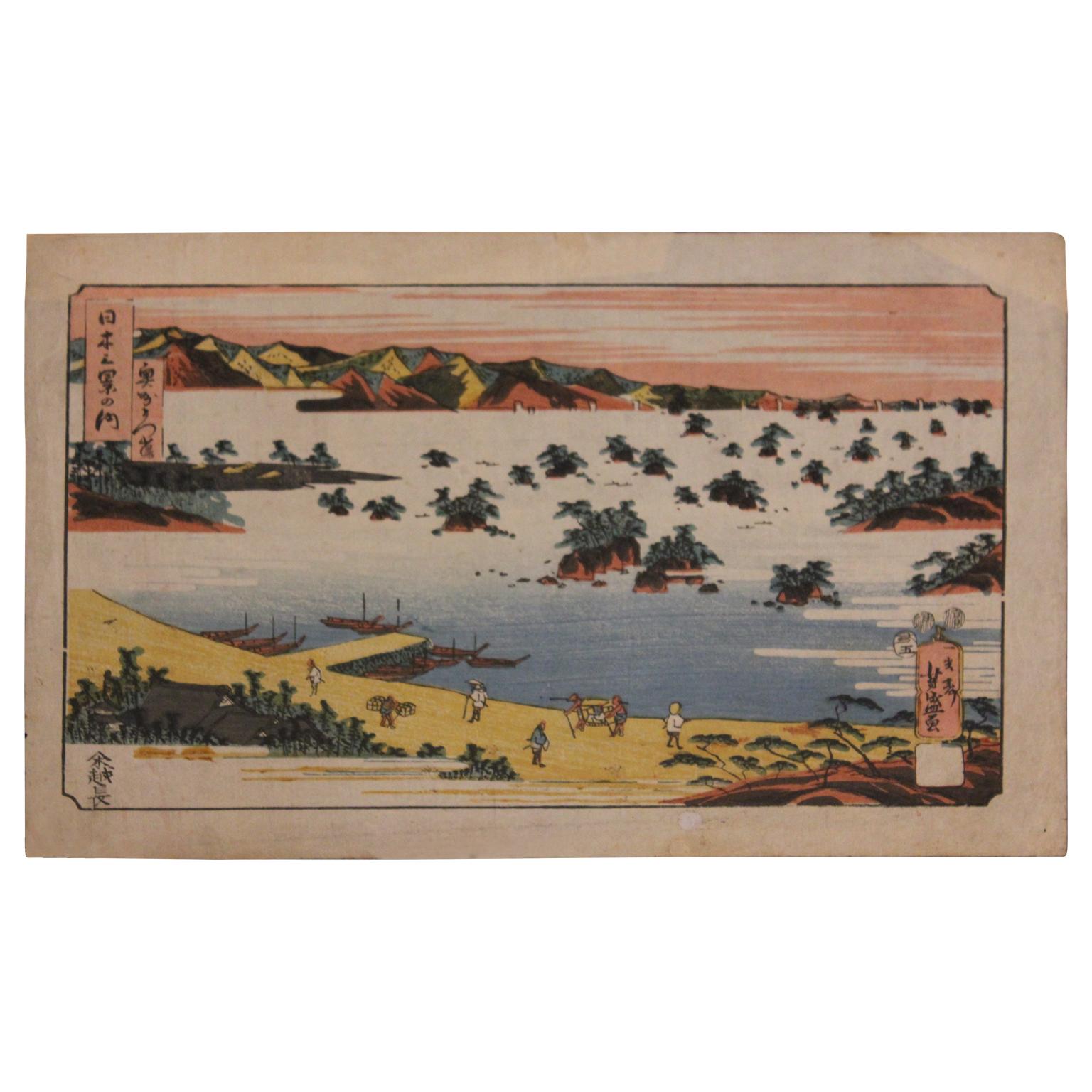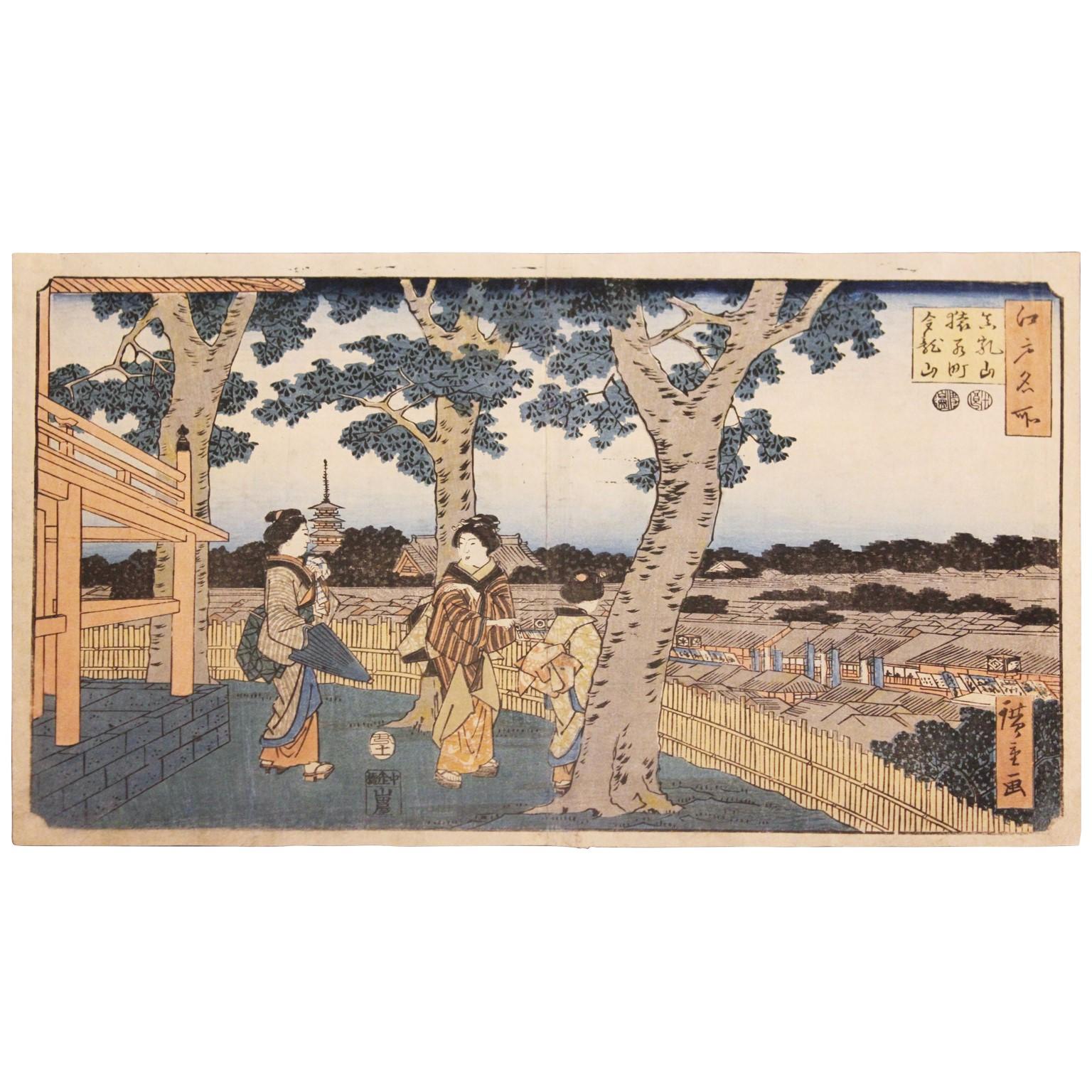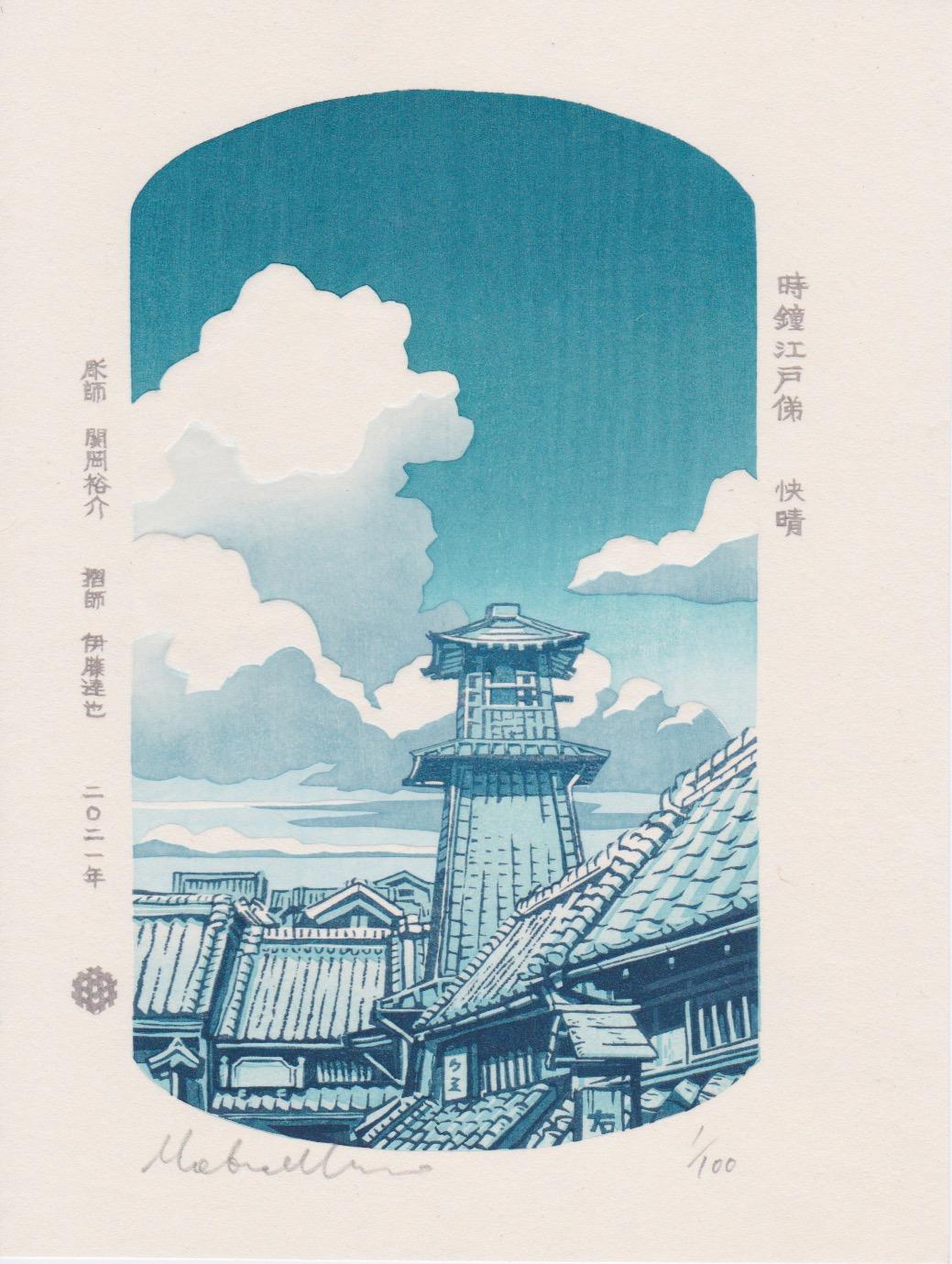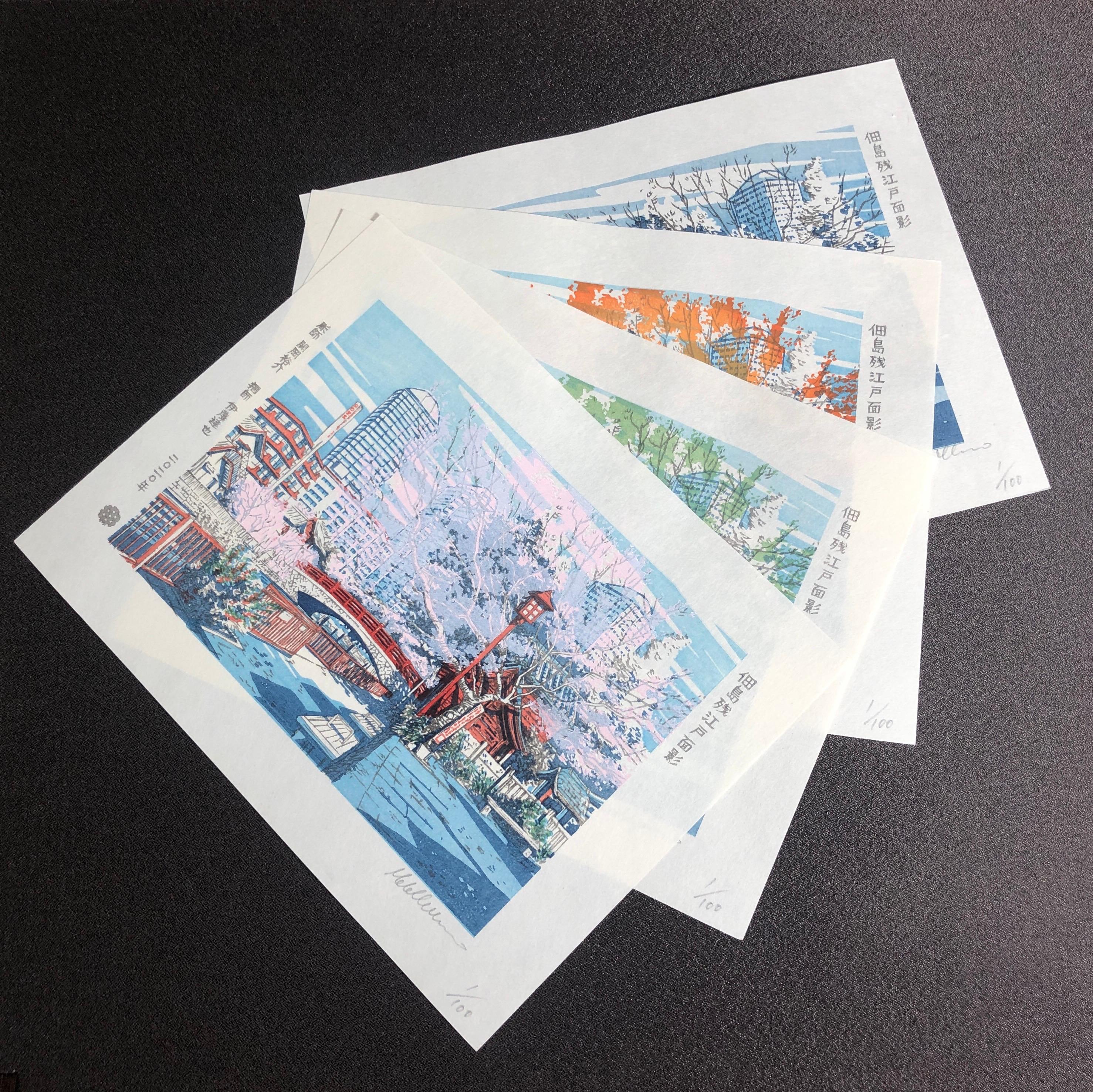Items Similar to Kintai Bridge at Iwakuni in Suo Province (Suo iwakuni kintai-bashi), 1859
Want more images or videos?
Request additional images or videos from the seller
Hiroshige IIKintai Bridge at Iwakuni in Suo Province (Suo iwakuni kintai-bashi), 18591859
1859
About the Item
Utagawa Hiroshige II (1829-1869), 'Kintai Bridge at Iwakuni in Suo Province' (Suo iwakuni kintai-bashi), from the series 'One Hundred Views of Famous Places in the Provinces' (Shokoku meisho hyakkei). woodblock print, 1859.
A fine, early impression, with rich, fresh colors, mica in the snow, and pronounced woodgrain, on cream Japan paper; the full sheet, in original condition, uncleaned and without repairs.
Signed Hiroshige ga, with publisher's seal Uoei of Uoya Eikichi, censor's and date seal Goat 11 aratame (1859).
Oban tate-e; image size 14 3/4 x 9 15/16 inches (506 x 375 mm).
The Kintai-bashi (Bridge of the Brocade Sash) crosses the Nishikawa (Brocade River) in Iwakuni. It was built in 1673 with five arches supported by wood pilings under the arches near the shore and four massive stone pilings engineered to withstand annual flooding that had destroyed earlier bridges with wood pilings. The original survived until 1950, when it was destroyed by a typhoon—the beloved bridge was reconstructed in 1953 by Iwakuni City.
The Kintai-bashi's graceful form, poetic name, and acclaimed feat of engineering made it one of the most famous bridges in Japan's provinces. Twenty-five years earlier, Katsushika Hokusai (1760-1849) included the bridge in his series, 'Unusual Views of Famous Bridges in the Provinces', depicting figures crossing the looping span during a rain shower.
Exhibited:
'Near and Far: Landscapes by Japanese Artists', The Clark Center for Japanese Art and Culture, Hanford, California, January 6 - April 20, 2013
Other impressions of this celebrated work are held in the collections of the Art Institute of Chicago, Asian Art Museum, British Museum, Clark Art Institute, Fine Arts Museums of San Francisco, Harvard Art Museums, and the Museum of Fine Arts Boston.
- Creator:Hiroshige II (1829 - 1869, Japanese)
- Creation Year:1859
- Dimensions:Height: 14.75 in (37.47 cm)Width: 9.94 in (25.25 cm)
- Medium:
- Movement & Style:
- Period:
- Condition:
- Gallery Location:Myrtle Beach, SC
- Reference Number:
About the Seller
5.0
Recognized Seller
These prestigious sellers are industry leaders and represent the highest echelon for item quality and design.
Platinum Seller
These expertly vetted sellers are 1stDibs' most experienced sellers and are rated highest by our customers.
Established in 1995
1stDibs seller since 2016
256 sales on 1stDibs
Typical response time: 1 hour
Associations
International Fine Print Dealers Association
- ShippingRetrieving quote...Ships From: Myrtle Beach, SC
- Return PolicyA return for this item may be initiated within 7 days of delivery.
More From This SellerView All
- Fountain of Sea Horses, Rome — Early 20th CenturyBy Rudolph RuzickaLocated in Myrtle Beach, SCRudolph Ruzicka, 'Fountain of Sea Horses, Rome', wood engraving, c. 1915. Signed, dated, and titled in pencil. Initialed in the block, lower left. A fine, richly-inked impression, on...Category
1910s American Modern Landscape Prints
MaterialsWoodcut
- 'Peking - Paifang Gate' — Mid-Century Watanabe Color WoodcutBy Cyrus Le Roy BaldridgeLocated in Myrtle Beach, SCCyrus Le Roy Baldridge, 'Peking '25', woodblock print, published 1926. Signed, titled, dated, and annotated 'No 124' in pencil. A fine impression, with fresh, undiminished colors; the full sheet, in excellent condition. Watanabe 6 mm seal, lower right, indicating an impression printed between 1945 and 1957. Archivally sleeved, unmatted. Image size 9 5/8 x 14 5/16 inches; sheet size 10 7/16 x 15 3/8 inches. ABOUT THE IMAGE A 'paifang', also known as a 'pailou', is a traditional style of Chinese architectural arch or gateway structure. It has been theorized that the paifang gate architecture was influenced by Buddhist torana temple gates. Paifang are designed with traditional Chinese architectural motifs including multi-tiered roofs, prominent supporting posts, and gracefully arched openings. This is an unusual ukiyo-e or 'floating world' woodcut published by Watanabe Shozaburo, Tokyo, in that the subject is of an early 20th-century scene in Peking, China. ABOUT THE ARTIST Cyrus Leroy Baldridge...Category
1920s Showa Landscape Prints
MaterialsWoodcut
- Tranquil Harbor (Gloucester, Massachusetts)By Lawrence WilburLocated in Myrtle Beach, SCLawrence Nelson Wilbur (1897-1988), 'Tranquil Harbor' (Gloucester, Massachusetts), wood engraving, edition 55, 1958. Signed in pencil, and signe...Category
1950s American Modern Landscape Prints
MaterialsWoodcut
- 'Chion-in Temple Gate' from 'Eight Scenes of Cherry Blossoms' — Jizuri SealBy Hiroshi YoshidaLocated in Myrtle Beach, SCHiroshi Yoshida, 'Chion-in Temple Gate (Sunset)' from the series 'Eight Scenes of Cherry Blossoms (Sakura hachi dai: Sakura mon)', color woodblock print, 1935. Signed in brush 'Yoshida' and in pencil 'Hiroshi Yoshida'. A superb, early impression, with fresh colors; the full sheet with margins, on cream Japan paper; an area of slight toning in the top right sheet corner, not affecting the image, otherwise in excellent condition. Marked with a jizuri (self-printed) seal, upper left margin. Self-published by the artist. Image size 9 5/8 x 14 3/4 inches (444 x 375 mm); sheet size 10 7/8 x 16 inches (276 x 406 mm). Archivally sleeved, unmatted. Provenance: M. Nakazawa, Tokyo. Literature: Japanese Landscapes of the 20th century (Hotei Publishing calendar), 2001, May. Collections: Honolulu Museum of Art, Museum of Fine Arts, Boston. ABOUT THE IMAGE Located in Kyoto, Chionin is the main temple of the Jodo sect of Japanese Buddhism, one of the most popular Buddhist sects in Japan, having millions of followers. The Sanmon Gate, Chionin's entrance gate, standing 24 meters tall and 50 meters wide, it is the largest wooden temple gate in Japan and dates back to the early 1600s. Behind the gate, a wide set of stairs leads to the main temple grounds. ABOUT THE ARTIST Painter and printmaker Yoshida Hiroshi (1876-1950) is regarded as one of the greatest artists of the Japanese 'shin hanga' (New Print) movement. Yoshida was born as the second son of Ueda Tsukane in Kurume, Fukuoka Prefecture, a schoolteacher from an old samurai family. In 1891 he was adopted by his art teacher Yoshida Kasaburo in Fukuoka and took his surname. In 1893 he went to Kyoto to study painting, and the following year to Tokyo to join Koyama Shotaro's Fudosha private school; he also became a member of the Meiji Fine Arts Society. These institutions taught and advocated Western-style painting, greatly influencing Yoshida’s artistic development. In 1899 Yoshida had his first American exhibition at Detroit Museum of Art (now Detroit Institute of Art), making the first of many visits to the US and Europe. In 1902 he helped reorganize the Meiji Fine Arts Society, renaming it the Taiheiyo-Gakai (Pacific Painting...Category
1930s Showa Figurative Prints
MaterialsWoodcut
- 'Hill' — 1930s American ModernismBy Paul LandacreLocated in Myrtle Beach, SCPaul Landacre, 'Hill', wood engraving, 1936, edition 60 (only 54 printed); only 2 impressions printed in a second edition of 150. Signed, titled, and numbered '49/60' in pencil. Wien...Category
1930s American Modern Landscape Prints
MaterialsWoodcut
- The Beach at Kaiganji in Sanuki Province — Lifetime Impression, 1934By Kawase HasuiLocated in Myrtle Beach, SCThe Beach at Kaiganji in Sanuki Province (Sanuki Kaiganji no hama), from the series Collected Views of Japan II, Kansai Edition (Nihon fûkei shû II Kansai hen), woodblock print, 1934. A very fine, atmospheric impression, with fresh colors; the full sheet, in excellent condition. Signed 'Hasui' with the artist’s seal 'Kawase', lower left. Published by Watanabe Shozaburo with the Watanabe ‘D’ seal indicating an early impression printed between 1931 - 1941. Stamped faintly 'Made in Japan' in the bottom center margin, verso. Horizontal ôban; image size 9 3/8 x 14 1/4 inches (238 x 362 mm); sheet size approximately 10 5/16 x 15 1/2 inches ( 262 x 394 mm). Collections: Art Institute of Chicago; Austrian Museum of Applied Arts (Vienna); Honolulu Museum of Art; Museum of Fine Arts, Boston; National Museum in Warsaw; University of Wisconsin-Madison. ABOUT THE ARTIST “I do not paint subjective impressions. My work is based on reality...I can not falsify...(but) I can simplify…I make mental impressions of the light and color at the time of sketching. While coloring the sketch, I am already imagining the effects in a woodblock print.” — Kawase Hasui Hasui Kawase...Category
1930s Showa Landscape Prints
MaterialsWoodcut
You May Also Like
- Japanese Beauty Admiring Kirifuri WaterfallBy Yoshu ChikanobuLocated in Burbank, CAA beauty turns to admire the Kirifuri Waterfall in Nikko Province. She holds the handle of an umbrella and wears fashionable clothing that is beautifully printed. This series pairs f...Category
1890s Edo Landscape Prints
MaterialsMulberry Paper, Handmade Paper, Woodcut
- Beauties on the Beach with view of Mount FujiBy Yoshu ChikanobuLocated in Burbank, CAShichirigahama, Sagami Province. A beauty in the foreground waves to her young companions, who run towards her on the beach. The beauty at left wears a western-style golden ring. We ...Category
1890s Edo Landscape Prints
MaterialsMulberry Paper, Handmade Paper, Woodcut
- Edo Landscape Japanese Woodblock PrintBy Utagawa Hiroshige (Ando Hiroshige)Located in Houston, TXEdo Meisho woodblock print of a famous Japanese coastal dock. This woodblock is most likely apart of the series "One Hundred Famous Views of Edo." The woodblock print is printed on r...Category
1850s Edo Landscape Prints
MaterialsWoodcut
- Saruwaka-machi District and Kinryûzan Temple Seen from MatsuchiyamaBy Utagawa Hiroshige (Ando Hiroshige)Located in Houston, TXThree women in the Saruwaka-machi District with a view of Kinryûzan Temple seen from the famous landmark Matsuchiyama. The woodblock print is from the series "Famous Places in Edo". ...Category
1850s Edo Figurative Prints
MaterialsWoodcut
- Vestiges of Edo at Bell Tower - NoonLocated in Koto-Ku, 13About Vestiges of Edo at Bell Tower (Toki no Kane Edo no Omokage) Artist: URBANOWICZ Mateusz Woodcarver: SEKIOKA Senrei III Printer: ITO Tatsuya Year: 2021 A former castle town situ...Category
2010s Edo Landscape Prints
MaterialsWoodcut
- Vestiges of Edo in Tsukuda - Set of Four SeasonsLocated in Koto-Ku, 13About Vestiges of Edo in Tsukuda (Tsukuda ni Nokoru Edo no Omokage) Artist: URBANOWICZ Mateusz Woodcarver: SEKIOKA Senrei III Printer: ITO Tatsuya Year: 2020 Our first original landscape ukiyo-e depicting Tsukuda, a neighborhood next to Tsukishima station in the east of Tokyo. This artwork highlights the striking contrast between the modern architecture and historical elements, that co-exist in harmony in Tsukuda today. The Japanese title Tsukuda ni Nokoru Edo no Omokage translates to “the vestiges of Edo in Tsukuda” - the word omokage (vestige) refers to the river, an aspect of old Edo that has continued to exist to this day, despite the fact that other things may have evolved or disappeared with time. When we trace back the history of ukiyo-e, we can see that there have been many foreign ukiyo-e artists who created important shin-hanga works in the 20th century, such as Paul Jacoulet, Elizabeth Keith...Category
2010s Edo Landscape Prints
MaterialsWoodcut
Recently Viewed
View AllMore Ways To Browse
Cream Japanned
Edo Woodcuts
Goat Print
Antique Showers
Japanese River Print
Japanese Edo Woodcut
Antique Mica
Antique Prints Boston
Japanese Rain
Antique Prints Chicago
Famous Japanese Woodblock Prints
Hiroshige Woodcuts
Antique Prints San Francisco
Japanese Woodblock Prints Hokusai
Hiroshige Woodblock Print
Hokusai Woodblock Prints
Japanese Print Rain
Japanes Prints Rain
